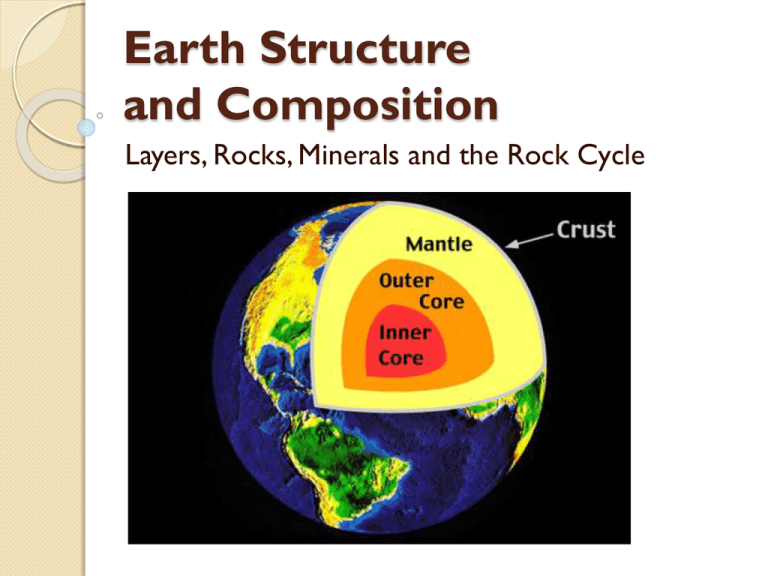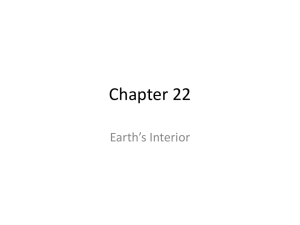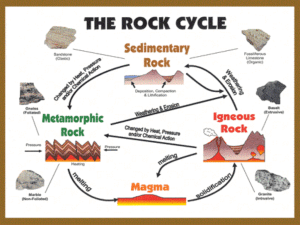13. Earth Structure, Rocks, Minerals and the Rock Cycle
advertisement

Earth Structure and Composition Layers, Rocks, Minerals and the Rock Cycle The Layers of the Earth The Earth is an oblate spheroid – the Solid Earth. It is composed of a number of different layers as determined by deep drilling and seismic evidence. The Four Basic Layers The crust is the layer that you live on, and it is the most widely studied and understood. The mantle is much hotter, has the largest mass, and several layers (uppermost/rigid mantle, asthenosphere, lower mantle). The outer core and inner core are even hotter with pressures so great you would be squeezed into a ball smaller than a marble if you were able to go to the center of the Earth! A More Detailed View of Earth’s Structure The Crust The Earth's Crust is like the skin of an apple. It is very thin in comparison to the other three layers. The crust is only about 3 - 5 miles thick under the oceans (oceanic crust) and about 25 miles thick under the continents (continental crust). The Crust The crust is composed of two different rocks. The continental crust is mostly granite. The oceanic crust is basalt. Basalt is much denser than granite. Because of this the less dense continents ride on the denser oceanic plates. The Mantle The Mantle is the largest layer of the Earth (1800 miles thick – 2/3 of earth’s mass), it is hot (5100 - 3300◦ F), and the source of most magma → (lava) The uppermost part of the mantle is rigid, and together with the crust, forms the Lithosphere The middle part of the upper mantle is composed of very hot dense rock that flows like asphalt, and it is called – asthenosphere The lower mantle is hot and dense. The Lithosphere The crust and the uppermost layer of the mantle together make up a zone of rigid, brittle rock called the Lithosphere. The Lithospheric Plates The crust of the Earth (which is part of the lithosphere) is broken into many pieces called lithospheric/crustal plates. The plates "float" on the soft, semi-rigid or plastic asthenosphere. The Asthenosphere The asthenosphere is the semi-rigid part of the upper mantle that flows like hot asphalt under a heavy weight. Convection Currents The asthenosphere "flows" because of convection currents. Convection currents are caused by the very hot material at the deepest part of the mantle rising, then cooling and sinking again – repeating this cycle over and over. When the convection currents flow in the asthenosphere they also move the lithospheric/crustal plates. The core of the Earth has a radius of 2100 miles and contains 1/3 of Earth’s mass. It is like a ball of very hot metals, with estimated temperatures of 12,400˚F at the center, and 8,600˚F at the outer limits. The Outer Core The outer core (1400 miles thick) is so hot that metals in it are in liquid state. It is composed of mainly melted nickel and iron → Earth’s magnetic sphere is largely related to this outer core The Inner Core The inner core of the Earth, about 700 miles thick, has temperatures and pressures so great that the metals are squeezed together and are not able to move about like a liquid, but are forced to vibrate in place like a solid. Core to Crust Earth Structure: Established Relationships Density of materials (rocks, minerals) greatest in the center (core), and decreases towards the surface Gravitational force strongest at the center, decreasing towards the surface Temperature also decreases from center to the periphery Pressure decreases from center to periphery as well Layers in earth’s internal structure are differentiated by composition, density, temperature and other characteristics Earth’s interior is an immense reservoir of minerals and geothermal energy Questions 1. What are the different layers in Earth’s Structure that are indicated on this diagram? 2. Which layers together constitute the Lithosphere? 3. Which layer is characterized by convection currents? 4. What layers are solid? Which ones are liquid and/or plastic? 5. Have we ever seen part of the Mantle? Explain. Detailed View of Earth’s Structure Rocks, Minerals and the Rock Cycle WHAT YOU LEARN • To distinguish between minerals and rocks • How rocks are classified • How rocks are constantly recycled providing materials for other rocks raw EARTH’S CRUST – Rocks and Minerals The earth’s crust is composed of rocks. Rocks are primarily composed of minerals (but may also contain organic materials). The granite and basalt rocks of the continental and oceanic crusts were the original, igneous rocks. What is a mineral? • • • • • A naturally occurring inorganic substance With a definite chemical composition and atomic structure Crystalline in nature, displaying consistent geometric shapes Commonly grouped into: Silicates, Oxides and Carbonates Also, metallic and non-metallic minerals What is a Rock? A rock is an aggregate of mineral particles – but may also contain organic materials So, minerals are essentially the building blocks of rocks Bedrock → Outcrop → Regolith → Soils Rock Classification • Igneous Rocks form due to the cooling and crystallization of magma • Sedimentary Rocks form through lithification of sediments from other rocks • Metamorphic Rocks form via recrystallization of other rocks due to heat, pressure, and chemical alteration IGNEOUS ROCKS Igneous Rocks Are Subdivided into Two Classes: Volcanic (Extrusive) Igneous Rocks Volcanic extrusive igneous rocks form on earth's surface as lava cools Basalt Basalt is the most widespread volcanic rock It is a dark, fine-grained rock Basalt is the rock of the sea floor Plutonic (or Intrusive) Igneous Rocks Plutonic igneous rocks form deep underground where magma cools slowly; these rocks have a coarse crystalline texture Granite Granite is the most widespread of plutonic igneous rocks. It underlies much of the continental crust. Igneous Rocks SEDIMENTARY ROCKS Most sedimentary rocks are formed of layers of materials that have washed into lakes, rivers and oceans – • Sedimentary rocks form strata • Often layers are tilted by earth movements • Sedimentary rocks contain fossils How do sediments turn into hard rock? Through Lithification Processes: Compaction Cementation Crystallization Subclasses of Sedimentary Rocks: 1. Clastic: form from bits and pieces of other rocks 2. Chemical: consist of minerals deposited from a solution 3. Organic: consist of organic matter such as plants and animal remains Organically-formed sedimentary rocks form from the remains of plants and animals (fossil limestone, coal) Sedimentary Rocks METAMORPHIC ROCKS Metamorphic rocks are rocks that have been changed in form due to heat, pressure, and chemical alteration. FOLIATED Slate Schist Gneiss NONFOLIATED Marble Quartzite Slate: forms when shale is compressed by heat and pressure; splits easily Schist: dominated by platy or needle-like minerals that form shiny layers Gneiss: under pressure the minerals in granite recrystallize to form bands of light and dark minerals Marble: Limestone recrystallizes into marble – a denser and more crystalline form of calcite Quartzite: Sandstone changes into quartzite; Sand grains recrystallize to form a hard mass of quartz Metamorphic Rocks HOW ROCKS RECYCLE ? The rock cycle is a general model that describes how various geological processes create, modify, and influence rocks The origin of all rocks can be ultimately traced back to the solidification of molten magma Magma consists of a partially melted mixture of elements and compounds commonly found in rocks Magma exists just beneath the solid crust of the Earth in an interior zone, the mantle The Rock Cycle shows how rocks of any rock class can be recycled into rocks of any other rock class. The Rock Cycle Stages in the Rock Cycle All rock types physically and chemically decomposed by a variety of surface processes collectively known as weathering The debris thus created often transported by erosional processes via streams, glaciers, wind, and gravity When this debris is deposited as permanent sediment, the processes of burial, compression, and chemical alteration over long periods of time produce sedimentary rocks Geologic processes like tectonic folding and faulting exert heat and pressure on both igneous and sedimentary rocks, altering them physically or chemically – rocks modified in this way are termed metamorphic rocks Any of the rock types can eventually be returned to Earth's interior by tectonic forces at areas known as subduction zones Once in Earth's interior, extreme pressures and temperatures melt the rock back into magma to begin the rock cycle again









